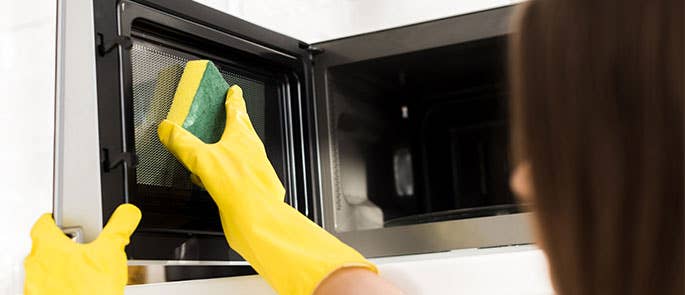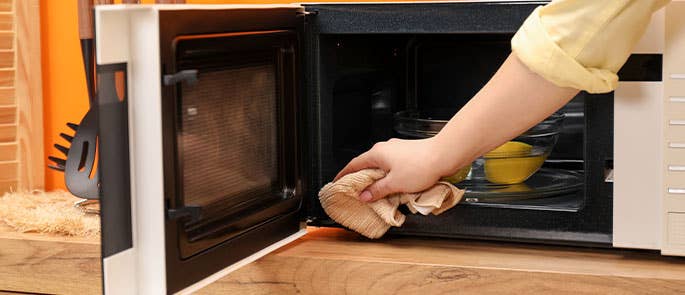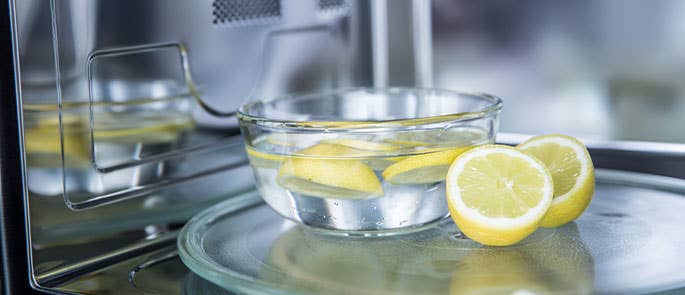How to Clean a Microwave
Microwaves are common kitchen appliances that you will find in most commercial and domestic kitchens. They are incredibly versatile and can be used for a myriad of different tasks such as cooking, re-heating or defrosting. As with any kitchen appliance it’s important that you regularly clean your microwave to maintain good standards of hygiene and to ensure its continued efficacy.
In this article we will explore why cleaning your microwave is so important and provide you with some top tips on the best way to clean a microwave.
Why Cleaning your Microwave is Important
All kitchen appliances should be regularly cleaned to maintain good levels of hygiene. Regular cleaning helps to keep your microwave free from dirt, grease and food debris. In turn, this reduces the risk of bacteria growing in your microwave which can cause foodborne illness and food poisoning. A dirty microwave increases the risk of cross contact and cross contamination from bacteria and trace amounts of other foods, such as allergens. As such, regular cleaning helps to reduce this risk by keeping your microwave free from bacteria and allergens. It also helps to reduce any odours from previous use that may be absorbed by other foods, thereby impacting their taste.

Regular cleaning ensures that your microwave is safe to use and helps to preserve its longevity and continued effectiveness. A dirty microwave is likely to be covered with food splatters and caked on dirt. This food debris can pose a fire risk as there is a chance that it can catch fire each time the microwave is used. If these food particles are left to build up then every time you use your microwave you are increasing the risk of them catching fire, posing a significant safety risk. Microwaves can be a fire hazard even when they are clean and it’s estimated that around 60% of fires start in the kitchen. Whilst most microwaves have built in safety features to reduce the risk of them catching fire, regular cleaning further reduces this risk. A dirty microwave is also an inefficient microwave as it has to work harder to heat food. As food particles build up they can block key elements of the microwave. For example, food debris can build up in the door seal making it less effective at sealing the microwave shut. Your microwave then has to work harder to heat food as energy is being lost through the compromised seal.
For those who use microwaves in a commercial setting, regular cleaning should be part of your day-to-day cleaning practices. Food businesses have a legal responsibility to keep customers safe and maintain high levels of hygiene. Regular cleaning is an integral part of this and something that a visiting Environmental Health Officer (EHO) will expect to see proof of during a food hygiene inspection. If they visit and see dirty appliances, such as the inside of a microwave covered in grease, it is highly likely that this will negatively impact your food hygiene rating.
Looking to Learn More?
Want to learn more? Kitchen appliances must be kept clean and free from traces of allergens to effectively manage them and keep customers safe. Learn more about food allergies and allergen management with our Food Allergen Awareness Training which provides you with essential information on food hypersensitivities and allergens, as well as guidance on how to comply with the UK’s allergen laws. During a food hygiene inspection an EHO will expect to see evidence of adequate allergen management. Learn more about what to expect during an inspection and how to stay inspection ready with our free Food Hygiene Rating Scheme Resource Pack.
How Often Should you Clean your Microwave?
All microwaves should be cleaned regularly, however microwaves in commercial kitchens will need to be cleaned more frequently. Cleaning should be a regular part of your daily activities and this should also include cleaning kitchen appliances. This may involve a daily wipe down and a weekly deep clean, or a more thorough cleaning every day at the end of a shift. It can be helpful to clean kitchen appliances at the same time to ensure consistent regularity. For example, if you wipe down your oven at the end of every shift and then deep clean it once a week, it’s a good idea to clean the microwave at the same time.
Microwaves in domestic settings also need to be cleaned regularly, however it’s unlikely to be as frequent as a microwave in a food business. The regularity of cleaning will greatly depend on how often you use the microwave. For example, if you only use it to occasionally re-heat meals then you may find it doesn’t get dirty as often and therefore doesn’t need to be cleaned as often. However, if you regularly use your microwave it’s a good idea to regularly clean it. Irrespective of the regularity, you should wipe down the inside of your microwave after every use. This is because any food particles that may have splattered on the interior will still be warm and will therefore be easier to remove.
Any spills on the outside or inside of a microwave should be cleaned up immediately, regardless of whether the microwave is being used in a domestic or commercial setting.

How to Clean a Microwave
There are countless different makes and models of microwave and they can vary greatly in size and shape. However, most microwaves have the same core components and can therefore be cleaned in a similar manner. Before cleaning your microwave you must check the manufacturer’s instructions to see if there are specific products that you should use or avoid when cleaning. Below you will find guidance on the best ways to clean a microwave. When cleaning any kitchen appliance, it’s important that you don’t use harsh, non-food safe chemicals as this can increase the risk of chemical contamination from chemical hazards.
How to Clean a Microwave Without Chemicals
There are numerous different cleaning products that you can purchase that will quickly cut through any grease and grime that has accumulated in your microwave. However, if you want to avoid using harmful chemicals to reduce the risk of chemical contamination, there are natural alternatives that you can use instead. It’s important to remember that not all natural solutions will have the same antibacterial properties as chemical cleaning products, so additional cleaning may be necessary in some situations.
How to Clean a Microwave with a Lemon 
To clean a microwave with a lemon:
- Fill a microwave safe jug with approximately 200ml of cold water.
- Slice the lemon in half and squeeze the juice into the water. Drop the lemon halves into the water as well.
- Microwave the jug on high power for around 3 minutes.
- After 3 minutes, let the jug stand inside the microwave with the door closed for around 5 minutes. Do not open the door as the steam will be hot and could cause burns. You also want to keep the steam trapped inside as this is what will loosen any dirt.
- Open the microwave and carefully remove the jug as it will be hot.
- Take out the microwave turntable and wipe it clean. You can wash this in the sink with warm soapy water if there are stubborn stains that will not come off.
- Wipe the inside of the microwave clean with a damp cloth, starting at the ceilings then working your way down to the sides and bottom of the microwave.
- For any stubborn marks, dip the cloth into the lemon water, ensuring the water has safely cooled down enough and scrub at the mark until it comes off.
- Don’t forget to clean the inside of the microwave door at the same time.
- Dry the inside with kitchen roll or a dry tea towel.
If you have noticed a burnt smell coming from your microwave, using lemon to clean it can help to remove the burnt smell. However, it’s important that you check all wires and cables are intact and show no signs of fraying if you can smell burning, as this smell may be caused by a fault rather than food debris.
How to Clean a Microwave with Vinegar 
You can use different types of vinegar for cleaning. However, white vinegar is relatively inexpensive and has a high acidity content which makes it the best choice for cleaning.
To clean a microwave with vinegar:
- Fill a microwave safe jug with approximately 500ml of cold water and add two tablespoons of white vinegar.
- Microwave the jug on high for around 5 minutes.
- After 5 minutes, let the jug stand inside the microwave with the door closed for another 5 minutes. Do not open the door as the steam will be hot and could cause burns. You also want to keep the steam trapped inside as this is what will loosen any dirt.
- Open the microwave and carefully remove the jug as it will be hot.
- Take out the microwave turntable and wipe it clean. You can wash this in the sink with warm soapy water if there are stubborn stains that will not come off.
- Wipe the inside of the microwave clean with a damp cloth, starting at the ceilings then working your way down to the sides and bottom of the microwave.
- For any stubborn marks, dip the cloth into the vinegar water, ensuring the water has safely cooled down enough and scrub at the mark until it comes off.
- Don’t forget to clean the inside of the microwave door at the same time.
- Dry the inside with kitchen roll or a dry tea towel.
As with using a lemon, if you have noticed a burnt smell coming from your microwave, using vinegar to clean it can help to remove the burnt smell and neutralise odours. Again, it’s important that you check all wires and cables are intact and show no signs of fraying if you can smell burning, as this smell may be caused by a fault rather than food debris.
How to Clean a Microwave with Baking Soda/Bicarbonate of Soda 
Whilst baking soda and bicarbonate of soda are often used interchangeably, sodium bicarbonate is commonly referred to as bicarbonate of soda or bicarb in the UK and this is what you should look out for when purchasing your cleaning supplies.
To clean a microwave with bicarb:
- Fill a microwave safe jug with approximately 200ml of cold water and add one tablespoon of bicarb. Stir till dissolved.
- Microwave the jug on high for around 5 minutes.
- After 5 minutes, let the jug stand inside the microwave with the door closed for another 3 minutes. Do not open the door as the steam will be hot and could cause burns. You also want to keep the steam trapped inside as this is what will loosen any dirt.
- Open the microwave and carefully remove the jug as it will be hot.
- Take out the microwave turntable and wipe it clean. You can wash this in the sink with warm soapy water if there are stubborn stains that will not come off.
- Wipe the inside of the microwave clean with a damp cloth, starting at the ceilings then working your way down to the sides and bottom of the microwave.
- For any stubborn marks, add more bicarb to the solution until it forms a paste. Spread the paste on the stains, leave for a few minutes and scrub till clean. Alternatively, you could place the solution back in the microwave for a few more minutes to try and loosen the dirt with more steam.
- Don’t forget to clean the inside of the microwave door at the same time.
- Dry the inside with kitchen roll or a dry tea towel.
As with using a lemon or vinegar, if you have noticed a burnt smell coming from your microwave, using bicarb to clean it can help to remove the burnt smell and neutralise odours. Remember, it’s important that you check all wires and cables are intact and show no signs of fraying if you can smell burning, as this smell may be caused by a fault rather than food debris.
How to Clean a Microwave with Water 
To clean a microwave with water, you can follow the same steps as cleaning it with a lemon, vinegar and bicarb, creating steam to loosen grease and dirt. However, whilst lemon, vinegar and bicarb all have antibacterial properties, water by itself does not. It’s therefore advisable to add a few drops of lemon juice or vinegar or a few tablespoons of bicarbonate of soda for their antibacterial properties.
To clean a microwave with water:
- Fill a microwave safe jug with approximately 200ml of cold water.
- Microwave the jug on high for around 5 minutes.
- After 5 minutes, let the jug stand inside the microwave with the door closed for another 3 minutes. Do not open the door as the steam will be hot and could cause burns. You also want to keep the steam trapped inside as this is what will loosen any dirt.
- Open the microwave and carefully remove the jug as it will be hot.
- Take out the microwave turntable and wipe it clean. You can wash this in the sink with warm soapy water if there are stubborn stains that will not come off.
- Wipe the inside of the microwave clean with a damp cloth, starting at the ceilings then working your way down to the sides and bottom of the microwave.
- For any stubborn marks, place the jug back in the microwave for a few more minutes to try and loosen the dirt with more steam.
- Don’t forget to clean the inside of the microwave door at the same time.
- Dry the inside with kitchen roll or a dry tea towel.
Water by itself will be less effective at neutralising odours than the methods listed above, however you can add a drop of lemon juice to the water to help mask any smells coming from your microwave.
How to Clean a Microwave with Dish Soap 
To clean a microwave with dish soap:
- Fill a microwave safe jug with approximately 200ml of cold water and add a few drops of dish soap.
- Microwave the jug on high for around 2 minutes.
- After 2 minutes, let the jug stand inside the microwave with the door closed for another 3 minutes. Do not open the door as the steam will be hot and could cause burns. You also want to keep the steam trapped inside as this is what will loosen any dirt.
- Open the microwave and carefully remove the jug as it will be hot.
- Take out the microwave turntable and wipe it clean. You can wash this in the sink with warm soapy water if there are stubborn stains that will not come off.
- Wipe the inside of the microwave clean with a damp cloth, starting at the ceilings then working your way down to the sides and bottom of the microwave.
- For any stubborn marks, squeeze dish soap onto a sponge and scrub till clean.
- Don’t forget to clean the inside of the microwave door at the same time.
- Dry the inside with kitchen roll or a dry tea towel.

How do you Clean the Inside of a Microwave?
To clean the inside of a microwave without the use of strong chemicals, follow the steps listed above.
To clean a microwave using cleaning products:
- Ensure that the microwave is cool to the touch.
- Spray the cleaner on all surfaces inside the microwave, don’t forget to spray the microwave ceiling.
- Wait a few minutes for the cleaner to work. Depending on the cleaning product that you are using you may have to wait a few minutes before you can start cleaning or you may be able to clean it up immediately. Carefully read the instructions to double check what you need to do.
- Using a damp sponge or cloth, wipe the inside of the microwave, starting at the ceilings then working your way down to the sides and bottom of the microwave.
- Remove the microwave turntable and wipe it clean. You can wash this in the sink with warm soapy water if there are stubborn stains that will not come off.
- For any stubborn marks, spray more of the cleaner on the stain and scrub till clean.
- Don’t forget to clean the inside of the microwave door at the same time.
- Dry the inside with kitchen roll or a dry tea towel.
How to Clean a Microwave Filter
Most microwaves that are designed to sit on a flat, heat resistant surface do not have filters that need to be cleaned. Microwaves that do have filters that need cleaning tend to be elevated and built in, such as those you would find above an oven. These types of microwave are not very common in the UK, however if you do have a microwave like this it’s important that you know how to clean the filter.
Microwaves that have filters tend to have both a grease filter and a charcoal filter. Grease filters are often stainless steel and can be cleaned with warm soapy water and a good scrub. If you have any stubborn stains, allow it to soak for a few minutes before scrubbing off any remaining food. Let the filter air dry, ensuring that it is completely dry before replacing it. Regular cleaning of a grease filter will help to prolong its life so you should aim to clean it every two to three months.
Charcoal filters are designed to help with odours. If your microwave has a charcoal filter it’s advisable to replace these every six months as they are not designed to be washed. Charcoal is used for odours as it has pores that can absorb smells. If these get wet, it negates the charcoal’s ability to absorb smells, rendering the filter redundant.
Microwave filter locations will vary depending on the brand and type that you have so it’s important that you check the manufacturer’s instructions to help you locate the filters and for any cleaning advice that pertains to your particular model. When removing a filter to clean or replace it, it’s advisable to also wipe down the surrounding area with a damp cloth.
How to Clean Rust in a Microwave
It’s not uncommon for microwaves to accumulate rust due to the moisture produced by heating food becoming trapped inside. Regular cleaning and leaving the microwave door open after use so that excess steam can evaporate can help to reduce the risk of rust. Moreover, whilst it’s not completely resistant to rust, stainless steel is generally more rust resistant than other materials. As such, if you purchase a stainless steel microwave it is less likely to accumulate rust.
If you want to avoid using chemicals when cleaning rust in your microwave, you can use many of the same natural alternatives, such as lemon juice, vinegar and bicarbonate of soda, that you would to clean the interior. There are many different ways to use natural cleaners to remove rust but the most common method is to make a paste with bicarbonate of soda and lemon or vinegar.
To clean rust in a microwave:
- Unplug the microwave and reposition it if necessary so that the rust is easily accessible.
- Clean the rusted area with a damp cloth or sponge to remove debris. Try to avoid using anything too abrasive as this can scratch the surface.
- Apply a rust removing cleaning solution or lemon/vinegar and bicarb paste to the rusted areas and leave to sit for about 30 minutes. If using a specific rust cleaning solution check the manufacturer’s instructions for guidance on how long you should leave the solution to sit.
- Remove the cleaner and repeat the process if some areas of rust prove to be more stubborn than others.
- Clean the entire interior of the microwave to remove any residual traces of rust.
- Ensure that the microwave is thoroughly dry before using it.
It’s perfectly possible to remove rust yourself and continue using your microwave as normal. However, in some instances rust may be a sign that your microwave is faulty, especially if you find that it’s rusting after only a few months of light use. In these instances, contact the manufacturer for guidance and, if necessary, a replacement. Whilst rust itself is not necessarily a fire hazard, it can increase the risk of electrical arcing. Rust is caused by moisture and moisture decreases the resistance between circuits which can cause short-circuiting, electrical shocks and electrical fires. Removing rust as soon as you spot it can help to prevent this from happening and reduce the risk of fire.

Microwave Cleaning Hacks
As well as the methods listed above, here are some microwave cleaning tips and tricks to help you keep your microwave clean!
- Use a cover – Microwave covers are inexpensive and readily available online and in stores. They help to contain any splatters and often have holes or a vent at the top to allow steam to escape and prevent overcooking.
- Wipe it down after every use – Wiping down your microwave after every use may seem like unnecessary extra labour but it helps to prevent grease and dirt from building up and burning over time. It doesn’t need to be a deep clean every time and a quick wipe with a damp sponge or some kitchen roll should be enough to help prevent build up.
- Don’t forget the outside – Microwave interiors are more likely to accumulate dirt, grease and bacteria but that’s not to say the outside doesn’t also get dirty. When cleaning your microwave be sure to clean the exterior as well.
- Be careful what you microwave – An undeniable appeal of microwaves is their versatility and the fact that they can microwave near enough any food. However, just because they can, doesn’t mean they should! We’ve all heard the horror stories of someone microwaving fish in the office kitchen and the smell wafting through the entire building. If you are trying to reduce odours, avoid microwaving food with strong smells that can linger such as fish, eggs and popcorn, especially if it burns.
Further Resources:
- Food Hygiene Courses
- How to Clean a Blender
- How to Clean an Oven
- How to Clean an Air Fryer
- How to Clean a Fridge
- Microwave Safety Guide
- How to Clean a Dishwasher







